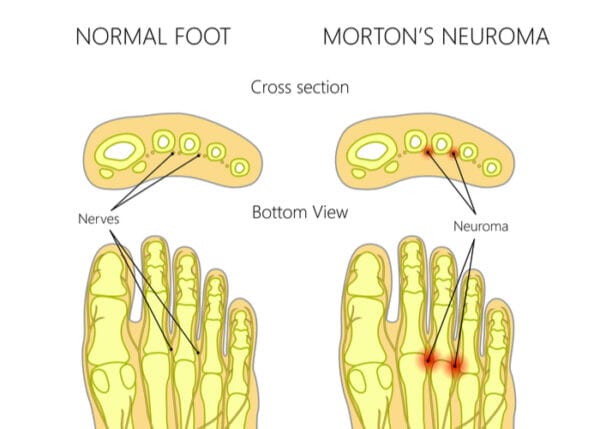Neuroma Surgeons
Are you experiencing numbness or tingling in your toes and/or feet? Do you feel like you are walking with a lump under the ball of your foot? If so, you might have Morton’s Neuroma. A neuroma is a benign (non-cancerous) growth or severe scarring that develops on a nerve. Morton’s Neuroma surgeons, Doctors C. Thomas Haytmanek and Jonathon Backus can diagnose and treat neuromas both surgically and non-surgically, depending on a patient’s need. If you believe you have a neuroma, or if you have been diagnosed with Morton’s Neuroma, contact The Steadman Clinic’s Sports Foot and Ankle team today!

What is a Neuroma and what causes it?
Neuroma is a benign (non-cancerous) growth or severe scarring that develops on a nerve. Morton’s neuroma typically affects the nerves of the foot causing pain, swelling, and discomfort. Also known as an interdigital neuroma, this growth is a thickening of tissue around the nerve leading to the toes. It can cause significant pain in the ball of the foot and feel like you are walking on a rock in your shoe or have a balled-up sock. As thickening progresses the pain can limit your ability to perform normal activities.
Morton’s Neuroma typically develops between the third and fourth toes and is usually caused by ongoing irritation, excessive pressure, or trauma. Less commonly, the neuroma develops in the second web space (between the second and third toes). Neuromas are 8 times more common in women and typically affect patients in middle age and beyond. The surgeons at The Steadman Clinic’s Sports Foot and Ankle clinic treat patients from Vail, Colorado, and the surrounding Eagle, Vail Mountain Ranges who have exhausted non-operative options to relieve neuroma pain and restore quality of life.
What are the symptoms of Morton’s Neuroma and how is it diagnosed?
Morton’s neuroma affects the nerves in the foot and often causes symptoms such as:
- Pain: The most common complaint from patients experiencing Morton’s Neuroma is sharp, burning, or shooting pain in the ball of the foot or under the toes. Pain is often made worse by walking without shoes on a hard floor, standing for prolonged periods, or wearing high heels or tight shoes (such as cycling shoes or ski boots). Pain can also take the form of a burning sensation or cramping in the affected area.
- Numbness or tingling: Patients experiencing neuroma may complain of numbness, and tingling, or frequently experience pins and needles in the affected area.
- Difficulty walking: Everyday movement like running, walking, and even simply weight bearing can cause severe pain and discomfort and limit everyday activity.
- Swelling: In some cases, Morton’s neuroma causes swelling in the ball of the foot.
- The sensation of having a lump: One of the most common symptoms is feeling as if there is a lump or mass like a marble or a pebble in the ball of their foot.
Symptoms can vary and may come and go. Often the pain is experienced during the day when a patient has been on their feet and subsides in the evening or overnight.

What are non-surgical options for a neuroma?
In the early presentation of Morton’s neuroma, it may help to change footwear; avoid high heels, narrow or tight shoes and choose shoes with a wide toe box. The goal is to avoid pressure on the nerves in the foot and toes, ideally allowing the bones of the foot to spread out when putting weight on the foot. By relieving pressure on the nerves, in time, it may heal.
Another simple treatment can be to add a metatarsal pad to the shoe. This is a felt or gel insert that is placed just behind (towards the heel) the metatarsal heads (also known as the ball of the foot). This pad can widen the space between the metatarsal heads and change the area seeing the most weight in the forefoot. Changing the forces in the forefoot can offload the inflamed nerve and allow it to heal.
Our doctors may also recommend orthotics that relieve pressure on the neuroma or suggest a corticosteroid injection to help relieve inflammation of the nerve. In certain cases, he may discuss alternative therapies.
When the severity of the condition has progressed or non-surgical options have not helped a patient regain their quality of life, Dr. Haytmanek or Dr. Backus may recommend Neuroma Surgery.
What is the surgery recommended for Morton’s Neuroma and what are the different surgical options?
Neuroma surgery has a high success rate and is often recommended for Morton’s Neuroma. Occasionally, a nerve decompression can be performed, leaving the nerve in its normal location. If the neuroma is larger or the patient has long-standing pain, the nerve may need to be removed (neurectomy).
For either approach, an incision can be made on the top of the foot near the space between the toes.
What can you expect from Neuroma Surgery?
An outpatient procedure can be performed with local anesthesia and sedation or general anesthesia. The surgery itself is typically less than an hour. After surgery pain and discomfort can be managed with pain medication and elevation. Most patients are allowed to fully weight bear in a protective, hard-soled shoe after surgery. Sutures are removed around two weeks after the surgery and patients are placed back into standard shoe wear. It may take several weeks or months for full recovery, and patients typically have an area of numbness in the forefoot.
